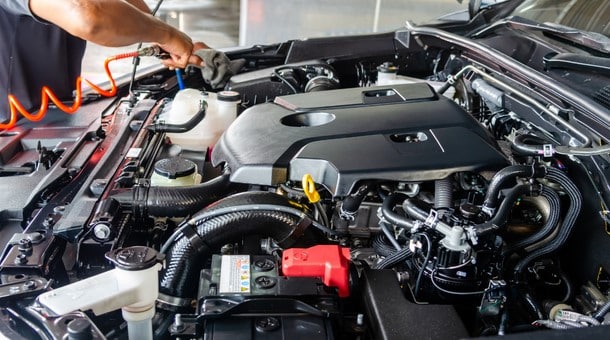This article will explain How Do Air Conditioning System Work in a Car. The car air conditioning system is a smaller version of the elements of the typical air conditioner. It includes an evaporator, compressor condenser, an expansion device, and a fan in a car to ensure air circulation in the passenger compartment.
The system for air conditioning draws energy from the engine’s crankshaft and can be operated by passengers in the cockpit through the push button assigned to the system.
What is an air conditioning system?
A cooling system is an electric device designed to eliminate an area’s moisture and heat. It is a method that is used in a variety of ways to provide a comfortable space, primarily for humans as well as other animals.
Why do We Need an Automobile or Car Air Conditioning System?
As we’ve already stated, the cabin’s air conditioning system must create a comfortable and healthy environment for people. This, in turn, offers comfort that is vital to the well-being of any human being. However, it is necessary for a vehicle because of the following motives.
- If a vehicle travels through cities such as Delhi in India, the passengers will have to be faced with a lot of traffic which results in slowing the cars. This is why a vehicle needs to have the ability to offer a comfortable environment for passengers.
- In India, during summers, there’s plenty of humid and hot air that makes it difficult for drivers to drive and for the passengers to travel, which is why in summer the need for a reliable cooling system for the air is needed in the car to create an air-conditioned and dry space inside the car’s passenger compartment.
- Air conditioning is not just used to improve the air quality inside a passenger’s cabin but also provides clean air that is essential in cities such as Delhi due to the dangerous air pollution which can lead to health problems for the passengers.
- In winter, a car is faced with the issue of fog or vapors that form over the front mirror, which can cause issues with visibility and makes it challenging for drivers to operate a vehicle which is why a car must be fitted with equipment to tackle this issue.
- There are a lot of changes in the climate in countries such as India in the long-term use of a vehicle that could create health problems for passengers. Therefore, a car must be able to maintain the human environment in its cabin throughout the journey.
Because of these issues, nearly every automobile on the roads nowadays is fitted with cooling systems, which is now necessary for every human being.
Components of Car Air Conditioning System.
The components of the car’s AC system are almost the same as that of an air conditioner in a room. However, there are many adjustments to car AC to keep it more compact and to make it compatible with the engine’s components. The parts used in car AC are:
Compressor
Its compressor is the heartbeat of your AC system. It’s a pump that moves the refrigerant across all other parts. The compressor has some moving parts that get worn out and may require replacement. At Natrad, we carry a complete range of compressor kits for more than 200 top vehicle brands and models.
Condenser
Its condenser is similar to a mini radiator. It converts the refrigerant in gas into a liquid and then releases the heat it has been carrying out of your vehicle by circulating it through fins and cooling coils. There are a variety of reasons your condenser may not work:
First, it’s usually near the side of the automobile. Therefore, it can be damaged easily in head-on collisions. Condensers can also be blocked or leak and must be replaced if they fail.
Evaporator
The Evaporator is located beneath the dashboard and is responsible for cooling the air before being blown out to the car’s interior. The liquid that is refrigerant evaporates and forms gas within the Evaporator. The fan then pushes the air through the cold tube.
Receiver-Dryer
It’s a security measure used in a car or vehicle air conditioning system since there is a possibility the opposite of vapors, a liquid is also flowing towards the compressor, which could damage the compressor.
Hence, the receiver dryer is placed between the compressor and Evaporator to turn the liquid into vapors before sending it to the compressor to be compressed.
Valve for expansion
It is a device used in the car air conditioning system to boost the high-pressure, low-temperature liquid refrigerant sent out to the condenser to reduce the pressure of the refrigerant before transferring it to an Evaporator for further processing.
Working in an Automobile or Car AC
The operation of an auto AC system is almost identical to the standard AC; however, there isn’t much difference.
- The Evaporator, another heater used in AC, draws the heat from the passenger cabin, which then transforms the refrigerant liquid flowing through the Evaporator into the form of vapors, which then provide cooling through the blower fans.
- This vapor with a high temperature but low pressure is transferred to the compressor, which increases the pressure of the vapors. This converts the refrigerant in vapors into liquids.
- The refrigerant is now in high pressure and a high-temperature liquid state.
- This high-temperature, the high-pressure liquid refrigerant then goes to the condenser that lowers the temperature of the refrigerant via forced convection produced through the condenser fan. This fanis the radiatorfan or the separate fan.
- Now, the refrigerant is operating at a low temperature. However, the liquid’s pressure is similar to that of the liquid.
- The high pressure and the low-temperature refrigerant then go into the expansion valve, releasing the refrigerant’s stress and transforming it back into its original form.
- The refrigerant is delivered to the Evaporator to complete the next cycle.
Conclusion
Air conditioning is nearly one-third of a vehicle’s most significant auxiliary load. Air conditioning systems today reduce the fuel efficiency of standard cars so any incremental improvement can provide substantial benefits in the near term because of the huge number of new vehicles sold yearly. However, for cars with high fuel efficiency, the current air conditioning systems have an incompatible impact on fuel efficiency.
FAQs about How Do Air Conditioning System Work in a Car
What kind of model system for an air conditioner is utilized in automobiles?
It is the expanding valve in the system. A fixed orifice tube is a system.
What is the power that car AC consumes?
The amount of energy your vehicle consumes is contingent upon your car’s model, make, and condition. On average, it requires around 3 kW to run your AC. It’s about 180 amps from your alternator circuit. The central compressor of your A/C is 750 watts and typically consumes between one to two Kilowatts in power.
Can turn off AC makes the car run faster?
The RAY says: Yes, it does, but you shouldn’t. It can provide an increase in power, but it doesn’t harm the vehicle.
Does AC deplete the battery in your car?
Switching on the AC creates an additional burden on the system, leading to the absence of the charging system. This, in turn, drains batteries.




